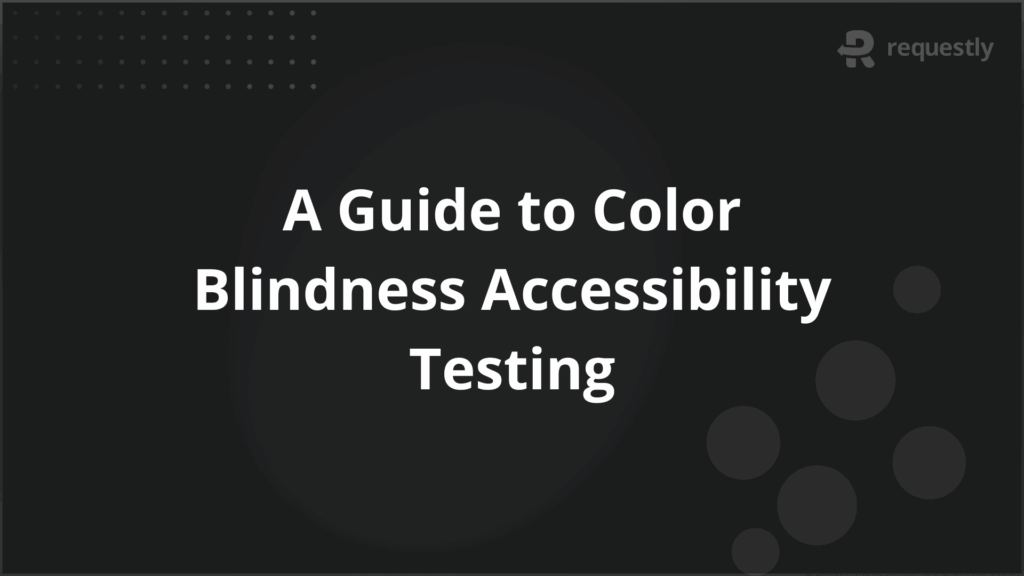A Guide to Color Blindness Accessibility Testing


Color is a powerful visual element in digital design, yet it’s also one of the most misused. For millions of people with color vision deficiencies (CVD), web content can become difficult or even impossible to navigate when color is used improperly. Approximately 1 in 12 men and 1 in 200 women are affected by some form of color blindness, making it a crucial consideration in accessibility design and testing. Ensuring websites are inclusive to color-blind users not only improves user experience but also aligns with compliance standards such as the WCAG (Web Content Accessibility Guidelines).
Understanding Color Blindness and Its Impact on Web Users
Color blindness refers to the reduced ability or inability to distinguish between certain colors. It occurs when one or more of the cone cells in the retina are absent, nonfunctional, or detect a different color than normal.
In the context of digital experiences, users with color blindness may face several challenges:
- Difficulty distinguishing between interactive and non-interactive elements when color is the only distinguishing factor.
- Charts, graphs, and data visualizations becoming incomprehensible when color-coded information lacks alternate visual cues.
- Low contrast between background and foreground elements rendering text unreadable.
- Forms and alerts relying solely on red-green indicators, which can be invisible to those with red-green CVD.
What is Color Blindness Accessibility Testing?
Color Blindness Accessibility Testing is the process of evaluating digital products—such as websites, applications, and documents—to ensure that individuals with color vision deficiencies can perceive and interact with all content effectively.
The main goal is to identify and eliminate barriers that may prevent users who are color blind from accessing information or completing tasks.
Why is it Important?
- Significant Population Impact: Around 1 in 12 men and 1 in 200 women worldwide have some form of color vision deficiency, making accessibility a critical consideration for inclusive design.
- Prevents Information Loss: Designs that rely solely on color to convey meaning (such as green means “success” and red means “error”) can prevent color blind users from understanding instructions, errors, or important cues.
- Legal and Ethical Compliance: Many countries have accessibility regulations and standards (such as WCAG) that require digital products to be usable by people with color blindness.
What does the Testing Involve?
Color blindness accessibility testing includes:
- Simulating Color Blindness: Using tools and browser extensions that mimic how pages look for users with various color vision deficiencies.
- Checking Color Contrast: Ensuring that foreground and background elements provide sufficient contrast so that all users can read content comfortably.
- Evaluating Use of Color Alone: Verifying that information is not conveyed by color alone—text labels, patterns, or icons should supplement color cues.
Key Principles of Accessible Design for Color Blind Users
Accessible design must accommodate users who perceive color differently. Core principles that aid color-blind accessibility include:
- Use of text labels and icons alongside colored indicators to convey information.
- High contrast between foreground and background to enhance readability.
- Avoiding color as the sole means of communication, especially in form validations or error messaging.
- Consistent use of patterns, textures, and shapes in data visualization to differentiate data points.
- Simplicity in color schemes, avoiding color combinations known to be problematic (like red-green or blue-purple).
Common Types of Color Vision Deficiencies
Different types of color blindness affect how users perceive various color spectrums. Understanding these helps tailor accessibility measures.
- Protanopia (Red-Blindness): A type of red-green color blindness where red cones are absent. Reds appear darker and can be confused with black or dark brown.
- Deuteranopia (Green-Blindness): Also a red-green deficiency, but here green cones are missing. It causes confusion between green and red or green and brown.
- Tritanopia (Blue-Yellow Blindness): A rare deficiency where blue cones are absent. Individuals may confuse blue with green, and yellow with violet.
- Achromatopsia: The rarest form, where individuals perceive no color at all. Everything appears in shades of grey.
- Anomalous Trichromacy: A less severe form where one cone type perceives color abnormally. This includes protanomaly (red-weak), deuteranomaly (green-weak), and tritanomaly (blue-weak).
Web Content Accessibility Guidelines (WCAG) and Color Accessibility
The WCAG provides a framework to guide developers and designers in creating accessible digital content. For color blindness, several success criteria are particularly relevant:
Key WCAG Principles for Color Accessibility
Here are the key WCAG principles for color accessibility:
1. Use of Color (WCAG SC 1.4.1)
- Requirement: Color must not be the only visual means of conveying information, indicating an action, prompting a response, or distinguishing a visual element.
- Implication: Supplement color coding with text labels, patterns, shapes, or icons. For example, in form validation, use both color cues (like red for errors) and textual error messages so that users with color blindness can still understand the feedback.
2. Minimum Contrast (WCAG SC 1.4.3 & SC 1.4.11)
- Contrast Ratio: The perceived difference in luminance between foreground (e.g., text) and background colors.
- Minimum requirements:
- Normal text: Contrast ratio must be at least 4.5:1 for Level AA compliance.
- Large text (≥18pt regular or ≥14pt bold): Contrast ratio must be at least 3:1.
- UI components and graphical objects: Contrast ratio must be at least 3:1 against adjacent colors.
- Enhanced compliance (Level AAA):
- Normal text: Minimum ratio of 7:1.
- Large text: Minimum ratio of 4.5:1.
3. Non-text Contrast and Focus Indicators (WCAG SC 1.4.11)
- UI controls: Visual boundaries of user interface components (like form elements and buttons) must be distinguishable with a contrast ratio of at least 3:1 compared to adjacent elements.
- Focus indicators: Any visual focus indicator (such as an outline or highlight when tabbing through content) must also meet this contrast requirement.
Content Type | Level AA Minimum Ratio | Level AAA Minimum Ratio |
Normal text | 4.5 : 1 | 7 : 1 |
Large text (≥18pt reg / ≥14pt bold) | 3 : 1 | 4.5 : 1 |
UI components/graphical objects | 3 : 1 | Not defined |
Tools for Testing Color Accessibility
Testing color accessibility ensures that digital products are usable for everyone, including individuals with color vision deficiencies. Below are leading tools that help designers and developers evaluate and improve color accessibility.
BrowserStack Accessibility Design Toolkit (Figma Extension)
An all-in-one Figma plugin that empowers design teams to integrate accessibility checks into their workflow. It enables real-time evaluation of color contrast and other key accessibility aspects during the design process.
Key Features:
- Built-in checks for color contrast, alt text, ARIA labels, and focus order
- Real-time, actionable accessibility suggestions directly within Figma
- Scans reusable components to ensure consistency
- Developer-ready annotations for seamless collaboration and handoff
- Supports WCAG (Web Content Accessibility Guidelines) compliance
Stark
A widely used accessibility toolkit available as Figma and Adobe XD plugins. Stark focuses on color contrast, color blindness simulation, and overall accessibility for design systems.
Key Features:
- Simulates various common types of color blindness
- Checks for sufficient color contrast based on WCAG requirements
- Generates accessibility reports and recommendations
- Offers suggestions for accessible palette replacements
- Integrates seamlessly into design workflows
Color Contrast Checker (WebAIM)
A free online tool for quickly evaluating the contrast between text and background colors. Ideal for checking compliance with WCAG color contrast requirements.
Key Features:
- Simple input of foreground and background colors in HEX or RGB
- Instant calculation of contrast ratio
- WCAG AA and AAA pass/fail indicators for both normal and large text
- Eyedropper tool for picking any on-screen color
Accessible Colors (Figma Plugin)
A streamlined Figma plugin designed to check and review the contrast between text and its background.
Key Features:
- Highlights color combinations that fail accessibility standards
- Quick reporting for full color palettes
- Recommendations for adjustments to achieve compliance
Color Oracle
Color Oracle is a free desktop application (Windows, Mac, and Linux) that simulates how images and designs appear to individuals with different types of color blindness. It helps designers and developers see their work through the eyes of users with color vision deficiencies.
Key Features:
- Applies a full-screen color filter independently of the design software in use
- Simulates the most common forms of color vision impairment: deuteranopia, protanopia, and tritanopia
- Allows instant toggling between normal and simulated color vision modes
- Effective for evaluating color choices in all types of visual content
Chrome DevTools
Chrome DevTools is a powerful feature set within the Chrome browser that helps developers assess webpage accessibility, including color and contrast issues.
Key Features:
- Built-in color contrast checker shows compliance with WCAG standards in the Styles pane
- Instantly highlights and suggests fixes for low contrast issues on any page element
- Interactive color picker for experimenting with accessible color combinations
- Emulates vision deficiencies (including some types of color blindness) to preview accessibility issues
- Provides contrast ratio pass/fail indicators directly within the development workflow
Implementing Color Accessibility in Web Development Workflows
Integrating color accessibility shouldn’t be a post-development fix. It must be embedded throughout the workflow:
Design Phase
- Use design systems and UI kits that enforce contrast standards.
- Preview designs with color blindness simulators.
- Collaborate with accessibility consultants or testers.
Development Phase
- Write CSS with variables to support theming and high-contrast modes.
- Use ARIA roles and semantic HTML to support screen readers and keyboard navigation.
- Build reusable components that support both color and non-color indicators.
Testing and QA Phase
- Automate contrast checks using linters or CI plugins.
- Perform manual checks in real browsers using DevTools simulators.
- Include accessibility tests in unit testing and end-to-end testing pipelines.
Maintenance
- Periodically audit accessibility as design updates roll out.
- Monitor user feedback channels for accessibility complaints or suggestions.
Challenges in Color Accessibility Testing
Despite available tools and best practices, several challenges hinder seamless implementation:
- Subjectivity in perception: Color perception varies even among individuals with the same type of CVD, making universal solutions complex.
- Dynamic content: Testing accessibility in real-time, interactive components like live charts or dashboards is more demanding.
- Design constraints: Brand guidelines may dictate color choices that conflict with accessibility principles, necessitating creative compromises.
- Lack of awareness: Teams often prioritize aesthetics over accessibility due to limited understanding or insufficient training.
- Inconsistent support across tools: Not all design or development platforms integrate accessibility checks natively, requiring additional effort and tooling.
Best Practices for Designing Color-Blind Friendly Interfaces
Integrating color-blind accessibility in design involves a mix of thoughtful planning and practical implementation. These best practices are essential:
- Choose accessible color palettes: Use tools to simulate how colors appear to users with CVD and adjust hues accordingly. Avoid red-green, blue-purple, and light yellow-grey pairings.
- Incorporate redundant cues: Always accompany color indicators with text, icons, or shapes (e.g., a warning icon along with a red highlight).
Use patterns and textures: In charts and maps, use stripes, dots, or different shapes to differentiate between categories. - Enable customization: Allow users to change color themes or contrast settings for personalized experiences.
- Label interactive elements clearly: Buttons, links, and toggles should be distinguishable by more than just color—use borders, shadows, or underlines.
- Ensure consistent contrast ratios: Use automated tools to validate color contrast against WCAG thresholds.
- Test with real users: Whenever possible, include users with color blindness in usability testing to gather authentic feedback.
Future Trends in Color Accessibility and Inclusive Design
As awareness grows, several trends are shaping the future of accessible design:
- AI-assisted color analysis: Emerging design tools use machine learning to recommend accessible color combinations in real-time.
- Design tokens with accessibility baked in: Organizations are adopting design systems where every color token has predefined contrast levels.
- Voice-first and multi-modal interfaces: These reduce dependence on visual cues, offering an inclusive experience beyond visual accessibility.
- Inclusive defaults: Platforms and CMS are increasingly adopting accessibility-by-default configurations to reduce developer overhead.
- Collaborative accessibility design: Cross-functional collaboration between designers, developers, and testers is becoming the norm, supported by shared design systems and accessibility documentation.
These shifts indicate a movement from compliance to inclusivity as a core value in digital product development.
Conclusion
By understanding how color vision deficiencies affect user interaction and following WCAG guidelines and design best practices, teams can significantly improve digital experiences for millions of users.
Proactive testing with simulation tools, coupled with inclusive development workflows and platforms like BrowserStack,Color Oracle, Stark, etc., ensures that applications are not just compliant but truly user-friendly for everyone.

Contents
- Understanding Color Blindness and Its Impact on Web Users
- What is Color Blindness Accessibility Testing?
- Why is it Important?
- What does the Testing Involve?
- Key Principles of Accessible Design for Color Blind Users
- Common Types of Color Vision Deficiencies
- Web Content Accessibility Guidelines (WCAG) and Color Accessibility
- Key WCAG Principles for Color Accessibility
- Tools for Testing Color Accessibility
- BrowserStack Accessibility Design Toolkit (Figma Extension)
- Stark
- Color Contrast Checker (WebAIM)
- Accessible Colors (Figma Plugin)
- Color Oracle
- Chrome DevTools
- Implementing Color Accessibility in Web Development Workflows
- Challenges in Color Accessibility Testing
- Best Practices for Designing Color-Blind Friendly Interfaces
- Future Trends in Color Accessibility and Inclusive Design
- Conclusion
Subscribe for latest updates
Share this article
Related posts





















